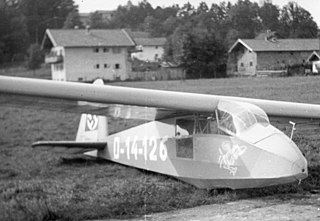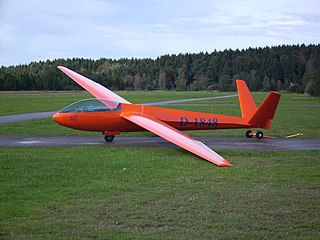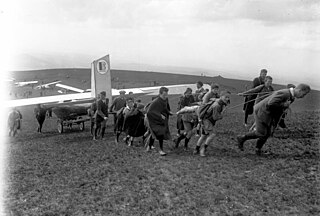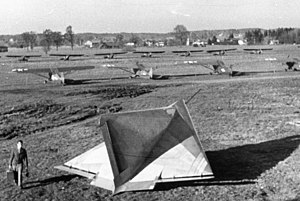
A delta wing is a wing shaped in the form of a triangle. It is named for its similarity in shape to the Greek uppercase letter delta (Δ).

The Convair XF-92 is an American, delta wing, first-generation jet prototype. Originally conceived as a point-defence interceptor, the design was later used purely for experimental purposes and only one was built. However, it led Convair to use the delta-wing on a number of designs, including the F-102 Delta Dagger, F-106 Delta Dart, B-58 Hustler, the US Navy's F2Y Sea Dart as well as the VTOL FY Pogo.

The Lippisch P.12, P.13a and P.13b were related design projects for a ramjet-powered delta wing interceptor aircraft studied in 1944 by German designer Alexander Lippisch. The P.12 and P.13a were unarmed, relying on reinforced wings to ram its opponent. The P.13a and b were to be powered by producer gas made in-flight from powdered coal. The DM-1 was a full-size glider, flown to test the P.12/13a low-speed aerodynamics. The design series were unrelated to the earlier P.13 produced by Messerschmitt's Lippisch design office.
The Lippisch P.13 was a 1942 design for a high-speed bomber aircraft by Josef Hubert. Of highly unconventional configuration, it was a tail-less, swept-wing design with an engine and propeller mounted at both the front and rear of the aircraft. A large ventral fin gave it an almost cruciform cross-section.
The Akaflieg Stuttgart fs17 was a glider aircraft that was designed and built in Germany from 1936. It notably featured a prone seating position for its pilot.
The Akaflieg Stuttgart fs18a was a glider designed and built in Germany from 1938. It was characterized by a gull wing and was the first glider to have a retractable undercarriage. Only one example of the design was constructed.

The Akaflieg München Mü10 Milan is a two-seat glider aircraft that was designed in Germany in 1934. Only one copy of the design was built.

The Akaflieg München Mü22 is a single-seat research glider designed and built in Germany from 1953.

The Akaflieg München Mü26 is a high performance single-seat glider designed and built in Germany starting in 1970.
Akaflieg Darmstadt is one of approximately twenty aviation groups attached to German universities. Akaflieg is an abbreviation for Akademische Fliegergruppe, an academic group of students and faculty from a German University.
The NRC tailless glider, also called the NRL tailless glider, was a two-seat tailless research glider designed by the National Research Council of Canada and built by the National Research Laboratories, at the instigation of G.T.R. Hill who had previously designed the British Westland-Hill Pterodactyl series of tailless aircraft.

The Akaflieg Darmstadt D-7 Margarete, often shortened to Darmstadt D-7 Margarete, was one of the earliest two seat monoplane gliders, designed and built by German university students in 1923.

The Akaflieg Darmstadt D-9 Konsul, often shortened to Darmstadt D-9 Konsul, was a high performance, single seat, cantilever monoplane sailplane, designed and built by a German University student group in 1923 for hill soaring.
The Akaflieg Darmstadt D-17 Darmstadt, also called the Darmstadt D-17 and Darmstadt I, was a high performance, single seat, cantilever monoplane sailplane, designed and built by a German University student design group in 1927. It was followed in 1928 by the Akaflieg Darmstadt D-19 Darmstadt 2, a similar aircraft with a new profile, longer span wing.
The Akaflieg Darmstadt D-28 Windspiel was a single-seat, high-performance sailplane designed in Germany in the early 1930s. Intended to exploit a growing understanding of thermal soaring, it was small and manoeuvrable, with a 12 m span; silk-covered for lightness, it weighed less (empty) than its pilots. It held the world straight-line distance record for a time in 1934.
The Akaflieg Darmstadt D-34 sailplanes were a series of experimental single seat sailplanes, designed at the University of Darmstadt in the 1950s and early 1960s to explore the structural and aerodynamic advantages of the then emerging plastics and composite materials.
The Akaflieg Darmstadt D-40 is an experimental variable geometry single seat sailplane, fitted with almost full span, camber changing flaps for optimum aerodynamics in weak thermals and integrated into the wing so as to minimise flap tip drag. One flew successfully but the D-40, like other variable geometry sailplanes, was not commercialised.

The RRG Fafnir, named after the legendary dragon, was a single seat German high performance glider designed by Alexander Lippisch. It won the Rhön competition in 1931 and made several outstanding flights as well as setting a fashion for gull wings.

Lore and a copy, Musterle, were high performance sailplanes designed at Darmstadt by Paul Laubenthal. Lore was flown successfully by the well known glider pilot Wolf Hirth at the 1929 Rhön (Wasserkuppe) glider competition. Musterle was used by Hirth used to demonstrate the possibilities of "blue sky" thermalling for the first time.

The Der Dessauer, later Der alte Dessauer, was a German single-seat glider built in the early 1920s. It took part in all the Rhön gliding contests on the Wasserkuppe between 1923 and 1928, flew in the Alps, and made a long-duration flight along the German sea shore.













